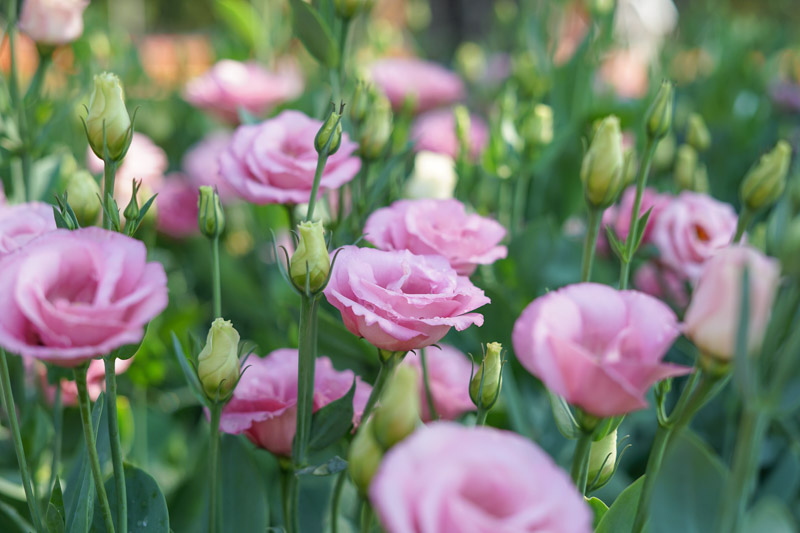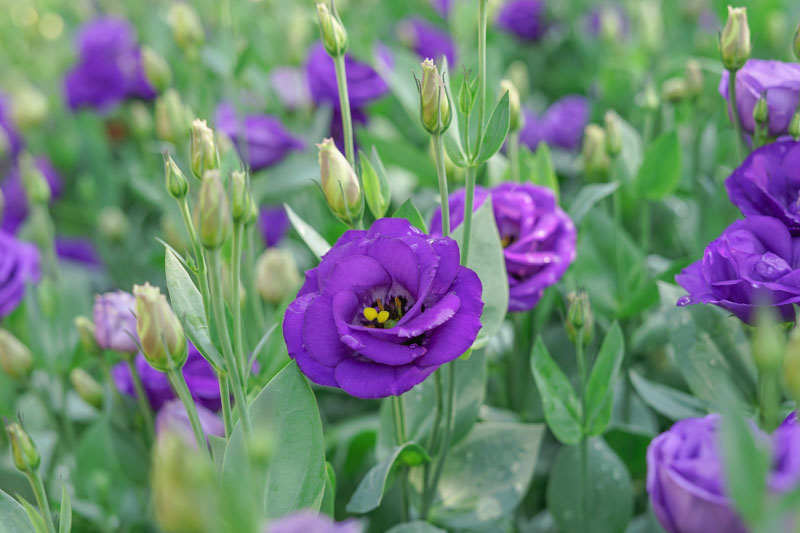Showy Prairie Gentian, Prairie Gentian, Texas Bluebells, Texas Bluebell, Bluebell, Lisianthus, Eustoma russellianum,
Eustoma grandiflorum, commonly known as Lisianthus or Prairie Gentian, is a captivating flowering plant renowned for its stunning, rose-like blooms. Its elegant and delicate flowers make it a favorite in floral arrangements and gardens alike.
Native: Originally native to the southern United States, Mexico, and northern South America, this plant has been cultivated worldwide for its floral beauty. In the U.S., it can be found in states like Texas, Nebraska, and Kansas, often in prairie lands, fields, and meadows, especially in areas adjacent to streams and tanks.
Plant Type and Habit: It is a single-stemmed or branching annual or biennial with an upright, bushy habit.
Size: Lisianthus generally reaches 12 to 36 inches (30-90 cm) in height and 10 to 12 inches (25-30 cm) in spread, depending on the variety and growing conditions.
Flowers: The show-stopping flowers resemble roses or peonies and come in a variety of colors, including white, pink, purple, and blue. Some cultivars also have bicolor or double-petal varieties. The bell-shaped flowers are prized for their long-lasting beauty in gardens and bouquets.
Bloom Time: It blooms from early summer to early autumn, depending on the climate and growing conditions.
Foliage: The plant features slightly fleshy, glaucous, gray-green leaves that are smooth and somewhat succulent in appearance.
Hardiness: Typically suited for USDA zones 8-10, it’s often grown as an annual in colder climates.
Uses: Its enchanting flowers make it a popular choice for bouquets and floral arrangements. It’s also used for container gardening and as a bedding plant.
Wildlife: Bees and butterflies are attracted to the flowers, making it a good choice for a pollinator garden.
Deer and Rabbits: The plant is generally resistant to deer, which tend to avoid it in favor of more palatable options.
Toxicity: It is generally considered non-toxic to humans and pets, although it’s always best to keep plants out of reach of small children and animals.
Invasiveness: Lisianthus is not known to be invasive and is generally easy to manage in a garden setting.
Eustoma grandiflorum is a versatile and striking plant that makes a meaningful addition to gardens and floral displays alike.

Growing and caring for Lisianthus requires some specific steps for best results:
The optimal planting time depends on your climate and whether you are growing it from seed, seedlings, or established plants.

Lisianthus is a relatively easy plant to care for but has challenges. Here are some common problems and potential solutions:
Solving these problems typically involves adjusting your care routine. Always diagnose the issue correctly before taking action, and consult reliable sources or professionals for advice if needed.
| Hardiness |
8 - 10 |
|---|---|
| Heat Zones |
1 - 12 |
| Climate Zones | 1, 1A, 1B, 2, 2A, 2B, 3, 3A, 3B, 4, 5, 6, 7, 8, 9, 10, 11, 12, 13, 14, 15, 16, 17, 18, 19, 20, 21, 22, 23, 24 |
| Plant Type | Annuals |
| Plant Family | Gentianaceae |
| Common names | Texas Bluebells, Lisianthus |
| Exposure | Full Sun |
| Season of Interest |
Summer (Early, Mid, Late) Fall |
| Height |
1' - 3' (30cm - 90cm) |
| Spread |
10" - 1' (25cm - 30cm) |
| Spacing | 12" (30cm) |
| Maintenance | Average |
| Water Needs | Average |
| Soil Type | Sand |
| Soil pH | Acid, Alkaline, Neutral |
| Soil Drainage | Moist but Well-Drained |
| Characteristics | Showy, Cut Flowers |
| Native Plants | United States, Southeast, Midwest, Rocky Mountains, Southwest, Kansas, South Dakota, Nebraska, Arkansas, Louisiana, New Mexico, Oklahoma, Texas, Montana, Colorado, Wyoming |
| Tolerance | Deer |
| Attracts | Bees, Butterflies |
| Garden Uses | Beds And Borders, Patio And Containers |
| Garden Styles | Mediterranean Garden, Cutting Garden, Informal and Cottage |
| Hardiness |
8 - 10 |
|---|---|
| Heat Zones |
1 - 12 |
| Climate Zones | 1, 1A, 1B, 2, 2A, 2B, 3, 3A, 3B, 4, 5, 6, 7, 8, 9, 10, 11, 12, 13, 14, 15, 16, 17, 18, 19, 20, 21, 22, 23, 24 |
| Plant Type | Annuals |
| Plant Family | Gentianaceae |
| Common names | Texas Bluebells, Lisianthus |
| Exposure | Full Sun |
| Season of Interest |
Summer (Early, Mid, Late) Fall |
| Height |
1' - 3' (30cm - 90cm) |
| Spread |
10" - 1' (25cm - 30cm) |
| Spacing | 12" (30cm) |
| Maintenance | Average |
| Water Needs | Average |
| Soil Type | Sand |
| Soil pH | Acid, Alkaline, Neutral |
| Soil Drainage | Moist but Well-Drained |
| Characteristics | Showy, Cut Flowers |
| Native Plants | United States, Southeast, Midwest, Rocky Mountains, Southwest, Kansas, South Dakota, Nebraska, Arkansas, Louisiana, New Mexico, Oklahoma, Texas, Montana, Colorado, Wyoming |
| Tolerance | Deer |
| Attracts | Bees, Butterflies |
| Garden Uses | Beds And Borders, Patio And Containers |
| Garden Styles | Mediterranean Garden, Cutting Garden, Informal and Cottage |
How many Eustoma grandiflorum (Lisianthus) do I need for my garden?
| Plant | Quantity | |
|---|---|---|
| Eustoma grandiflorum (Lisianthus) | N/A | Buy Plants |
Create a membership account to save your garden designs and to view them on any device.
Becoming a contributing member of Gardenia is easy and can be done in just a few minutes. If you provide us with your name, email address and the payment of a modest $25 annual membership fee, you will become a full member, enabling you to design and save up to 25 of your garden design ideas.
Join now and start creating your dream garden!
Create a membership account to save your garden designs and to view them on any device.
Becoming a contributing member of Gardenia is easy and can be done in just a few minutes. If you provide us with your name, email address and the payment of a modest $25 annual membership fee, you will become a full member, enabling you to design and save up to 25 of your garden design ideas.
Join now and start creating your dream garden!